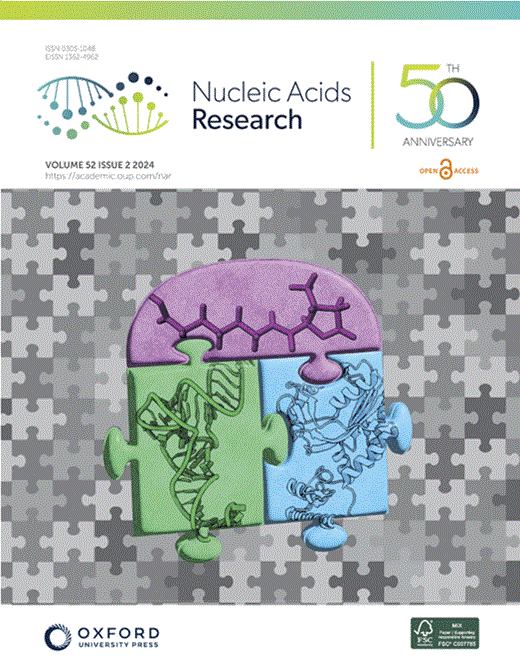翼状螺旋结构域和富芳香环之间的有效协调重组了atp酶结构域,并促进了人类RECQ1对DNA的解绕
IF 16.6
2区 生物学
Q1 BIOCHEMISTRY & MOLECULAR BIOLOGY
引用次数: 0
摘要
RecQ解旋酶可以解开广泛的DNA结构,从而保护细胞免受基因组不稳定的影响。细菌和人类的RecQ解旋酶解旋机制已被广泛研究。dna诱导的螺旋翼(WH)结构域重定位和atp酶结构域的变构重塑对细菌RecQ解旋酶的解绕活性很重要。相比之下,人类RECQ1在DNA或核苷酸结合时没有观察到这种改变的构象状态。在这项研究中,我们已经结晶和表征了一个工程RECQ1,它包含一个柔性的甘氨酸丝氨酸连接体,插入锌结合和WH结构域之间。含有结构体的连接体显示出更有效的DNA结合和解绕活性。工程RECQ1与DNA复合物的晶体结构表现出解旋酶和WH结构域的构象重排,导致结构更加紧凑。我们的结构首次表明,改变β发夹尖端和ARL之间的距离有利于DNA结合,并重塑atp酶结构域,导致底物识别和解绕活性的改变。这些结构重排对于WH结构域和解旋酶结构域之间的有效协调,将DNA结合和ATP水解耦合到链分离是必要的。本文章由计算机程序翻译,如有差异,请以英文原文为准。
Efficient coordination between the winged helix domain and the aromatic-rich loop restructures the ATPase domain and facilitates DNA unwinding by human RECQ1
RecQ helicases can unwind a wide spectrum of DNA structures and thereby protect the cells from genome instability. Unwinding mechanisms have been extensively studied for bacterial and human RecQ helicases. DNA-induced winged helix (WH) domain repositioning and allosteric remodeling of the ATPase domain have been shown to be important for unwinding activity of bacterial RecQ helicases. In contrast, no such altered conformational state was observed for human RECQ1 upon DNA or nucleotide binding. In this study, we have crystallized and characterized an engineered RECQ1 containing a flexible glycine serine-rich linker inserted between the zinc binding and WH domains. The linker containing construct exhibits more efficient DNA binding and unwinding activity. A crystal structure of the engineered RECQ1 in complex with DNA exhibits conformational rearrangements of the helicase and WH domains, resulting in a more compact structure. Our structure, for the first time, demonstrates that alteration of the distance between the tip of the β-hairpin and the ARL favors DNA binding and remodels the ATPase domain, leading to alteration in substrate recognition and unwinding activity. These structural rearrangements are necessary for efficient coordination between the WH domain and the helicase domain, coupling DNA binding and ATP hydrolysis to strand separation.
求助全文
通过发布文献求助,成功后即可免费获取论文全文。
去求助
来源期刊

Nucleic Acids Research
生物-生化与分子生物学
CiteScore
27.10
自引率
4.70%
发文量
1057
审稿时长
2 months
期刊介绍:
Nucleic Acids Research (NAR) is a scientific journal that publishes research on various aspects of nucleic acids and proteins involved in nucleic acid metabolism and interactions. It covers areas such as chemistry and synthetic biology, computational biology, gene regulation, chromatin and epigenetics, genome integrity, repair and replication, genomics, molecular biology, nucleic acid enzymes, RNA, and structural biology. The journal also includes a Survey and Summary section for brief reviews. Additionally, each year, the first issue is dedicated to biological databases, and an issue in July focuses on web-based software resources for the biological community. Nucleic Acids Research is indexed by several services including Abstracts on Hygiene and Communicable Diseases, Animal Breeding Abstracts, Agricultural Engineering Abstracts, Agbiotech News and Information, BIOSIS Previews, CAB Abstracts, and EMBASE.
 求助内容:
求助内容: 应助结果提醒方式:
应助结果提醒方式:


